A DIY Campervan conversion can save a lot of money. But where do you start? We’ll share everything you need to know so you can do the best van build!
Van life is merely a dream for many people. It’s something you see on Instagram, read about in travel blogs, or watch on YouTube channels. The reality is it’s a lot easier to embark on your very own van adventure than you think. You need to take the plunge and just do it.
The first step is having the idea — it all starts with that. From there, it’s all about convincing yourself that you can do it and commit to buying a van. Then the real fun starts — your very own DIY camper van conversion.
This starts with the planning phase which is probably the most important aspect — what’s going to go where, how you’re going to fit your van out, and what you’re going to put in it. It’s also one of the most exciting parts as you get to design your very own layout, scroll through countless blogs, and start making your dream a reality.
The purpose of this article is to guide and assist you in building a campervan so that you don’t make the same mistakes as many before you have. If you’re reading this post, you’re already on the right track. A van conversion is both a challenging, but fun task, so don’t underestimate it. Go into your DIY van build project with both an open mind and confidence.
So let’s jump to the fun stuff and get started with The Ultimate DIY Campervan Conversion Guide!
Table of Contents
Building a DIY Campervan Conversion
The beauty of a DIY camper van conversion is that you’re able to fully customize your van to suit your needs. Most RVs are well-equipped to tackle the open road, but some things just might not work for you.
The stove might be in an awkward place for you or the bed might be too low for your liking. But if you convert a van yourself, you can put everything right where you want it.
However, it all depends on how much floor space you have available to work with inside your camper van. This will dictate what setup you’re able to install. This all depends on the van that you decide to buy.
This brings me to the first consideration — what is the best van for your custom DIY conversion?
Best Van for DIY Conversion
This is a highly subjective topic. What I like might be different from what you like. And what works for my needs will no doubt be different from what works for your needs.
There are, however, certain vans that have been tried and tested and the idea is to provide you with a few options to look into so that you can decide for yourself.
Mercedes Benz Sprinter Van
One of the most popular cargo vans for a campervan conversion is the Mercedes Benz Sprinter van. They are synonymous with van life and one of the most popular vans on the road. They come in 4×4 options and are extremely reliable as they are built with German precision.
There are many van builds out there and there is always information to find online given their popularity. If you’re looking for a great conversion van that will be perfect for your van life adventure, then look no further than the Mercedes Sprinter.
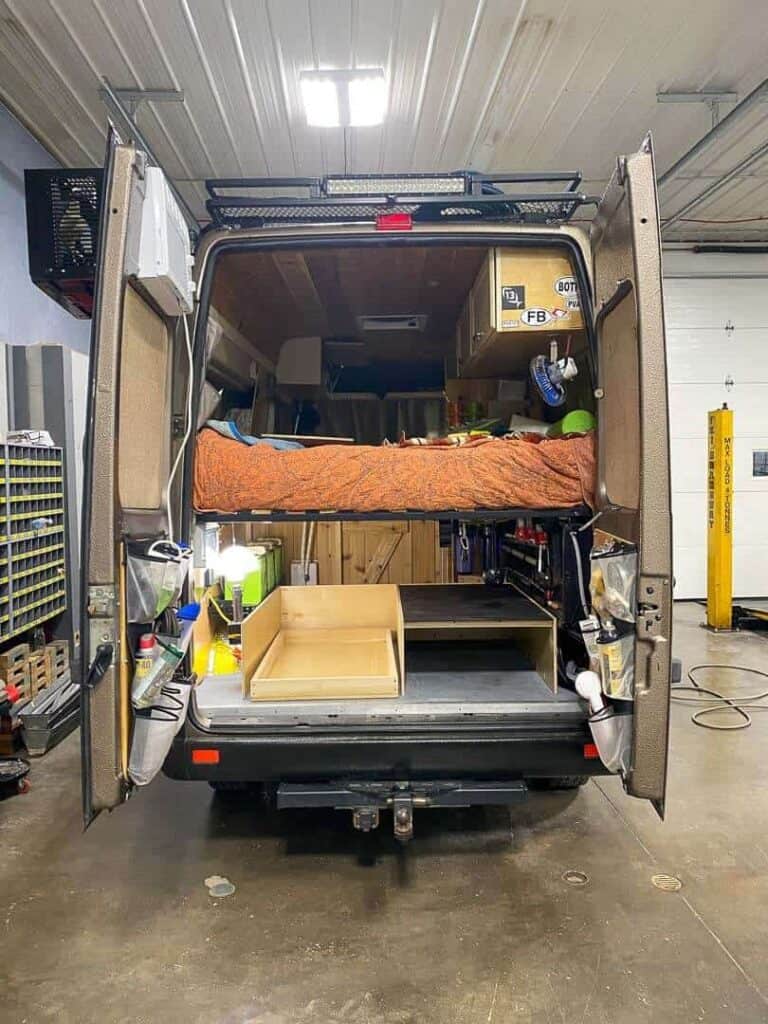
Ford Transit Van
The Ford Transit van definitely gives the Mercedes a run for its money. It’s a newer van on the market, but since its introduction it has gained popularity amongst the van life fraternity. They come in a range of height and length options, so depending on your needs there’s something to suit you.
They’re also a lot more affordable and the services and maintenance can be done by a regular neighborhood mechanic, as opposed to Mercedes that need a professional to work on them.
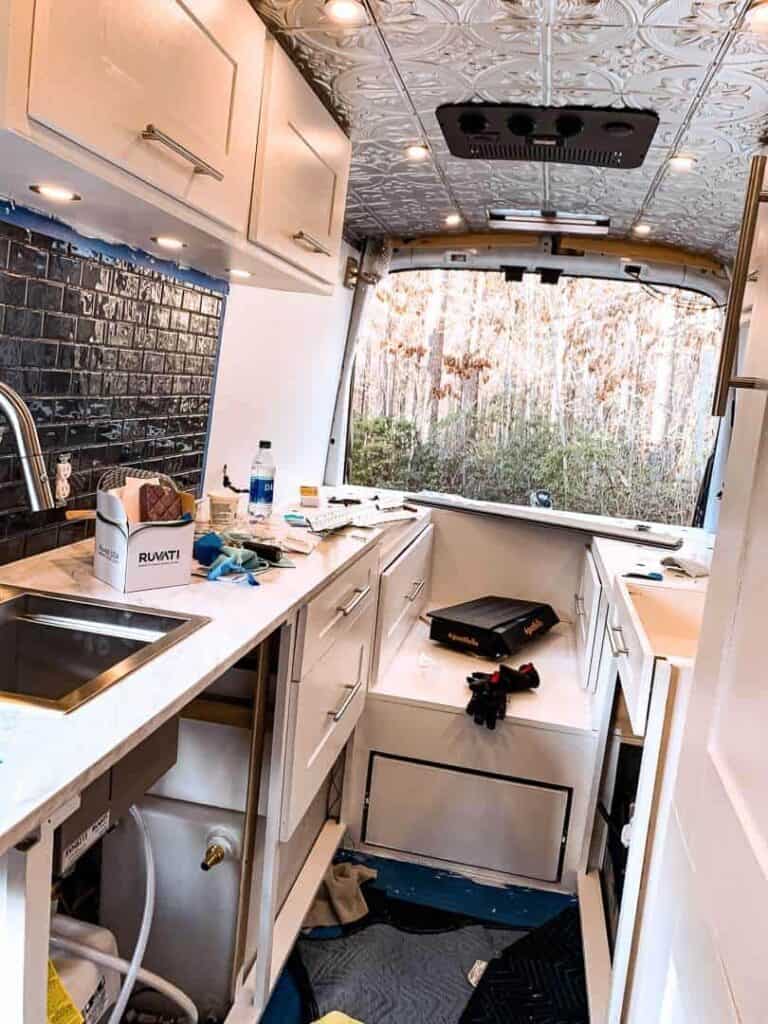
VW Bus
The VW vans, such as the Vanagon and Westfalia, are the classics when it comes to van life. They are already fitted out with some pretty neat features as standard, such as a gas burner stove, fridge, and plenty of storage space. They’re also maneuverable and easy to park given their size and often feature a pop-up roof for additional headroom.
There are a couple of downsides to owning one of these classics though. Parts are hard to come by, maintenance is expensive, and they aren’t very efficient on gas. But I can look past these because the VW vans are real head-turners.
Ram Promaster
The Dodge Ram Promaster is a great van option that is both affordable and easy to maintain. They come in an array of different height and length models and are also one of the widest vans on the market meaning more living space and of course, more storage space.
The one small downside is that the Promaster doesn’t have the best ground clearance. This means that they aren’t a great option if you’re looking to do some serious off-road missions. You could get caught high and dry and there’s also unfortunately no 4×4 to help you out either.
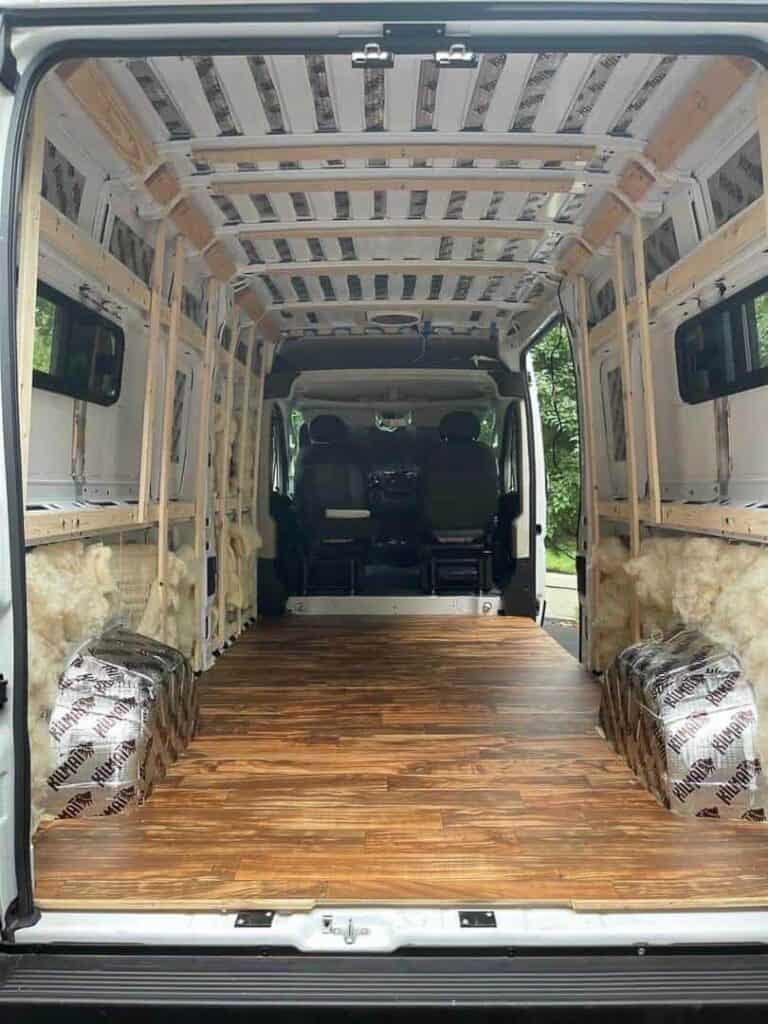
School Bus (Schoolie)
Lastly, a schoolie is a whole different beast entirely. They can be converted into apartments on wheels because space is your friend when it comes to a school bus van conversion. I’ve seen some of the most incredible schoolie conversions that could rival a New York apartment in terms of size and fit-out.
The huge disadvantage to having all that wonderful space is their overall size. They are huge compared to a regular cargo van which means they are a real mission to maneuver and park. This is especially problematic if you are in residential areas and campgrounds.
Read Next: Check out our post on the best vans for van conversion!
Planning Layout (purpose)
When planning the layout of your campervan conversion, there are a number of important considerations before you start cutting, hammering, and drilling.
Like everything in life, if you fail to plan, you plan to fail. A DIY camper van conversion is no different — and the last thing you want is to cut something out or have to install something twice. As they say: “Measure twice and cut once.”
Here are a few important things to consider when planning your van layout:
- What do you intend to do with your van? Will you be living on the road temporarily or full-time?
- How many people will be living in your van? The more people, the more space you will need
- Are you a digital nomad who needs a place to sit and work? A fold-down desk or your dining table are places where you can work.
- Are you wanting a fixed bed or one that folds away? Remember, space isn’t your friend, but there is no sacrifice for a good night’s sleep. You can also have storage space underneath if you opt for the fixed option
- Do you have a million hobbies like me? If so, you’ll need to think about storage space for your surfboards, bicycles, fishing sticks, etc.
- How tall are you? The taller you are, the more headroom you require. Some vans come with standing headroom, some have pop-up roofs.
- Are you a passionate cook? If you’re going to be doing lots of cooking inside your van (we don’t recommend it if you can avoid it — oil and cooking smells) then you’re going to want a sink, water supply, gas burner, etc.
Van Electric & Solar
When you’re planning your dream van build, one of the most important things to include is your electric and solar systems. This depends on how much power you require to run your van and everyday appliances.
Many van lifers choose to be self-sustainable and off the grid, and this is possible thanks to solar panels and developments in high-power battery packs.
Every modern-day van lifer should consider being able to be self-sufficient when it comes to power. And if you plan your DIY campervan conversion well, you can easily achieve this. Let’s take a look at what you require:
- Solar panels – these will help you to harvest the powerful rays from the sun and convert them into usable power. You can charge your battery packs that will ultimately power your van
- Batteries – the power source of your van. Batteries will allow you to store power in 12v format that will be able to power things such as your lights, fan, fridge, and USB ports that you can plug into your cigarette lighter port.
- Portable Power Station – These guys are the ultimate must-have when it comes to van life. They can power your entire van and recharge using solar panels attached to your van’s roof or on the ground. Thank me later.
- Inverter – An inverter will allow you to use your appliances that normally plug into your wall sockets at home, in your van. Another super important van life accessory — it converts 12v DC into usable AC current for your plugs (laptop charger being the most important one).
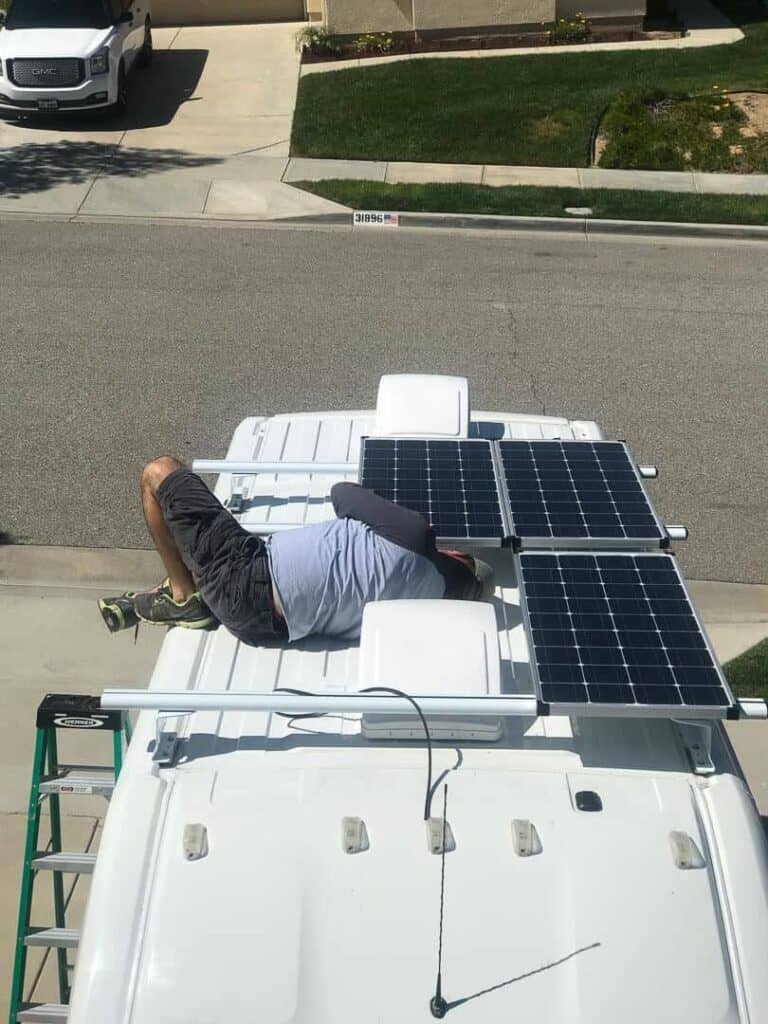
Water & Plumbing
Your DIY van build planning process should make considerations for water and plumbing. This is of the utmost importance if you want access to water inside your van for drinking, showering, a toilet, and cooking.
Having running water and things such as a toilet and a shower takes it from van living to van life. If you’re going to be spending extended periods of time on the road, then you’re going to want to be comfortable.
Let’s look at some water and plumbing considerations below:
- Freshwater tank – this is where the freshwater for your entire van system will be stored. The size that you install will depend on your daily water needs, but you should always have enough to at least last a few extra days just in case. Remember, when full, it adds a significant amount of weight to your van and should be installed in the right place to ensure your van is balanced.
- Grey water tank – this is where the wastewater from your shower and sink will go. Your camper van will need one if you’re planning on having running water and a shower.
- Black water tank – this is where the waste from your toilet will go. If you get yourself a self-composting toilet, then you remove the need for a black water tank. I would highly recommend this option.
- Sink with a tap – This is one of the basic van life requirements. This is water for cooking, washing hands, and drinking. There are great options for folding sinks on the market which double as a counter.
- Toilet – while a flushing toilet is an option for your DIY van conversion, I would rather recommend one of the self-composting toilets on the market. This removes the need for a water supply and a black water tank — efficiency! A portable toilet is also another option to consider
- Shower – a shower in your camper van is great. But you’ll need the space and also a water heater of some sort if you want hot water. Another option is an external solar shower. They’re easy to set up and harvest the sun’s rays — did I mention these are free?
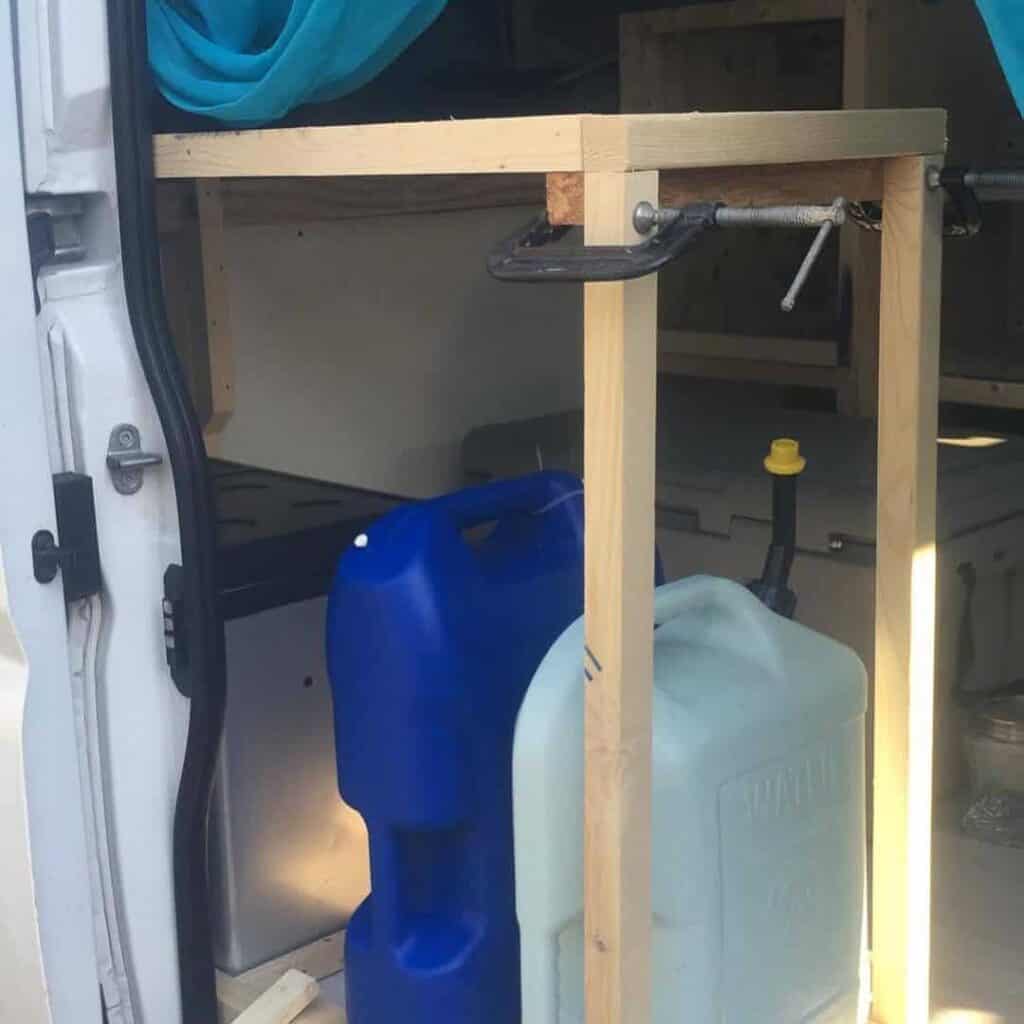
Heating & Cooling
As I mentioned, the difference between van living and van life is comfort. Having a well-ventilated camper van is essential as living in a van can get smelly and stuffy quickly because it is such a small, confined space. You also want to keep your van cool in the summer and warm in the winter.
Ventilation can be achieved in the following ways:
- Windows and window deflectors
- A vent fan
- Portable 12v fans
- An AC unit
Keeping warm in the winter can be achieved by the following:
- Propane/diesel heaters
- Portable heaters
- Blankets
- Body warmth from another person
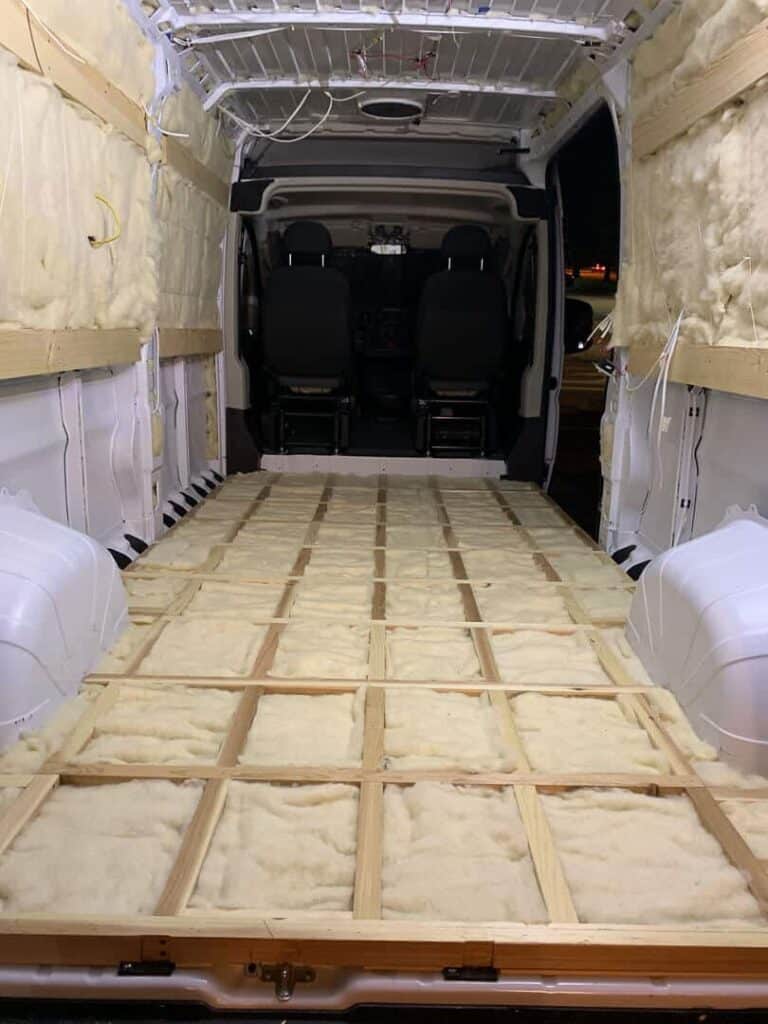
Van Bathroom Setup
Your camper van bathroom can range from being super basic to posh (and complex). There are many different bathroom setup options available and it all depends on your requirements and how much storage space you have inside your allocated bathroom space.
Your DIY van conversion can have the option of a toilet and shower and both can be fixed into your camper van or portable and used outside.
- Toilet – a fixed toilet can either be plumbed and have a water supply and outlet to a black water tank, but it can also be a self-composting option and require neither (recommended)
- Shower – there are a number of different shower options available, from a fixed shower that is both hot and cold water supplied to a basic outdoor shower that is solar operated.
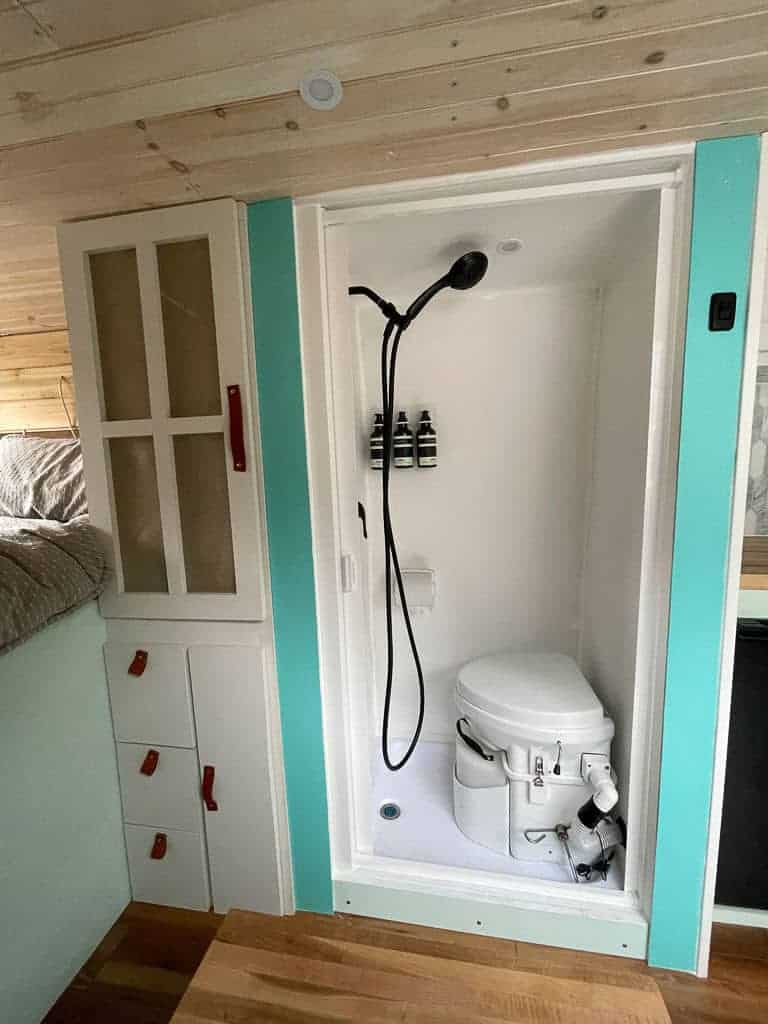
Van Bedroom Setup
One of the most important things when it comes to your DIY campervan build is your bedroom setup. This is where you’re going to spend many hours of the night and you want to ensure that it is comfortable.
There are a number of different bed options available to you. They can either be a fixed high bed with amazing storage underneath or a convertible bed. These are a great option too as they function as a couch and workspace during the day and convert into a bed at night.
There is also storage below the couch which is less than what you would get if you installed a fixed high bed, but at the end of the day, it all comes down to personal preference.
READ MORE: Check out all of these great campervan bed setup options!
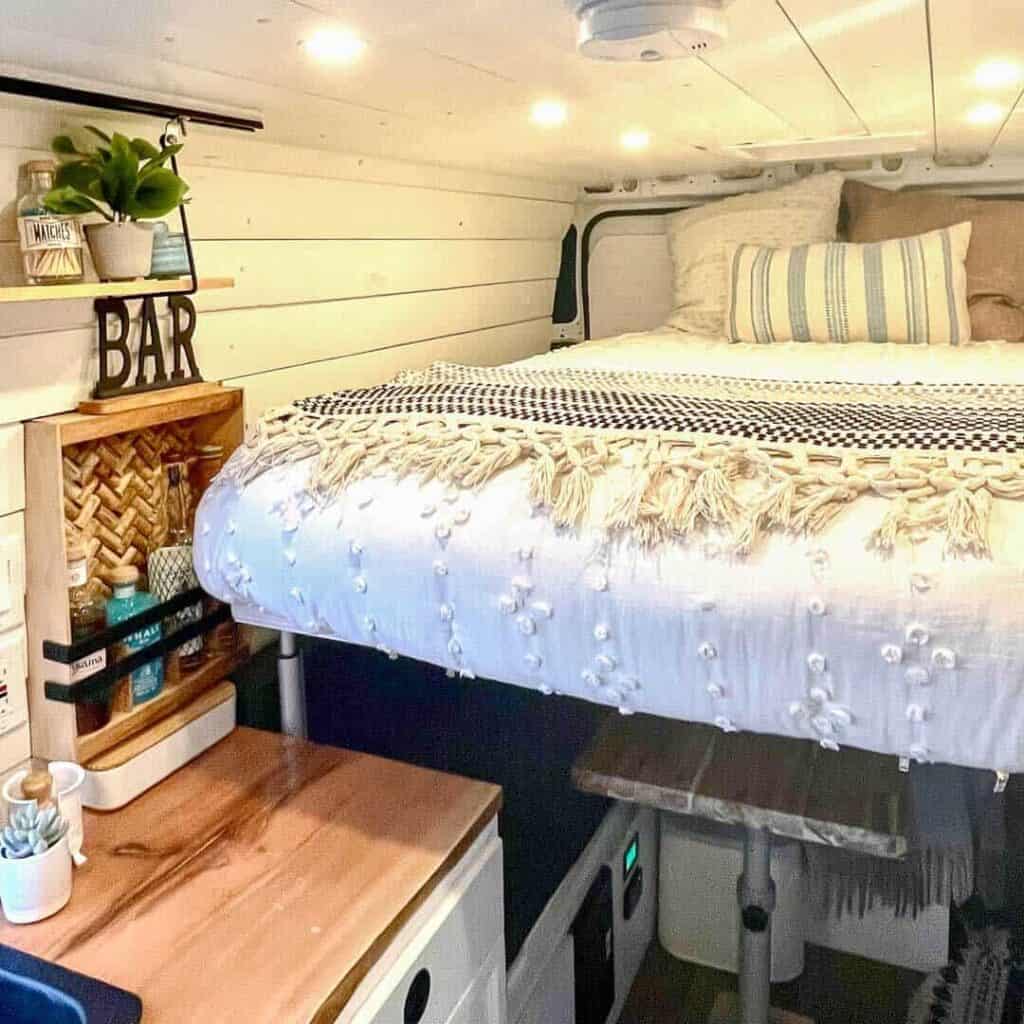
Van Kitchen Setup
The place where all your Masterchef creations come to life. Your van kitchen is home to many appliances that will make life on the road that much more comfortable. Depending on your preference, once again, you can have the following appliances in your own campervan kitchen:
- Stove – a propane gas cooker
- Fridge – can be an electrical system or use 12v
- Sink – a kitchen essential for washing hands and preparing food. Fold-away options are recommended as they double as counter space and some have cooker plates too
- Oven – many prefer not to have one for lack of space but small gas ovens are a great addition to any DIY camper van build.
READ MORE: Check out these great campervan kitchen design ideas!
Van Insulation
Van insulation is one of the most important factors when converting your camper van into a home on wheels. It will keep you cool in the summer and warm in the winter.
There are various methods to insulate your van and various places within your van body to install insulation. There are various places within your van to install insulation such as under the floors, in the walls and ceiling, and the windows.
Here are a few products to check out for insulating your van:
- Reflectix
- Extruded Polystyrene (XPS)
- Sheep’s wool batts
- 3M Thinsulate
- Closed Cell Spray Foam
Van Lighting
Keeping your van well-lit is crucial, having other forms of ambiance lighting is an added homely luxury. Lighting should be an integral part of your van conversion layout when kitting out your new or used van.
A van is a small space and you can make it incredibly homely and comfortable by using lighting. There are various lighting options that you can consider for your DIY van conversion to ensure that lighting isn’t merely an afterthought.
- Recessed puck lighting
- String lights
- 12v reading lamp
- 12v Fairy lights
- LED light bar
- LED strip lights
- Solar-powered lights and lanterns
Van Flooring
There are many different floor options available for your tiny home on wheels and again, personal preference will dictate what you choose. There are also a number of different things to consider when it comes to your van floor. Things such as appearance, cost, feel, weight, and durability are all factors to consider.
The different floor options available for your DIY van conversion are:
- Cork flooring – sustainable, insulating, and beautiful, but expensive and timely to install
- Luxury vinyl plank (LVP) – durable, easy to install, and easy to clean, but not the cheapest and not environmentally friendly
- Sheet vinyl – waterproof, inexpensive, and lightweight, but difficult to repair and requires adhesive to install
- Rubber flooring – durable, sustainable, and non-slip, but heavy, can smell, and not very aesthetically pleasing
- Linoleum – non-toxic, water-resistant, and made from renewable materials, but susceptible to moisture, dents, and scratches
- Laminate flooring – cost-effective and visually appealing, but timely to install and doesn’t handle moisture well
- Hardwood flooring – looks and feels amazing, but is really heavy and timely to install
Walls & Ceilings
Walls and ceilings are an important visual consideration in your camper van but also house electrics and insulation within your van. In other words, they are both functional and fashionable.
Proper planning in the layout of your camper van walls and ceilings is crucial in order to account for cables, plumbing pipes, insulation, and other important things you wish to conceal. After the function aspect is covered, it’s down to the fashion — the look and feel of your walls and ceilings.
The most common options for wall and ceiling finishes are:
- Luan Plywood – lightweight and can be painted
- Shiplap or Tongue and Groove Planks – most common material, but can get heavy
- Aluminum Composite Panels (ACP) – durable but heavier than luan plywood
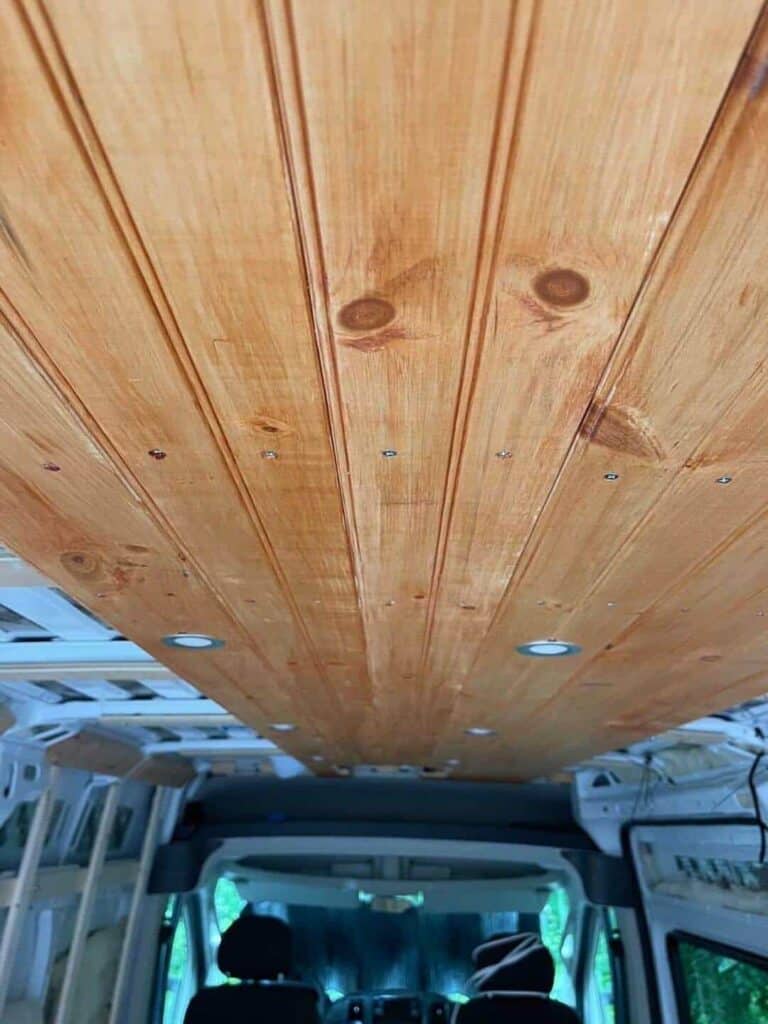
Refrigeration
Different refrigeration options are available for your conversion van and again, they depend on personal preference and of course, space.
These options are as follows:
- Upright fridge – easy access to groceries
- Chest refrigerator/freezer – sometimes stacking is required making it difficult to access items
- Coolers/ice box – the cheapest option, but always requires an ice top-up
READ MORE: Don’t miss out on our recommendations for the best campervan fridges.
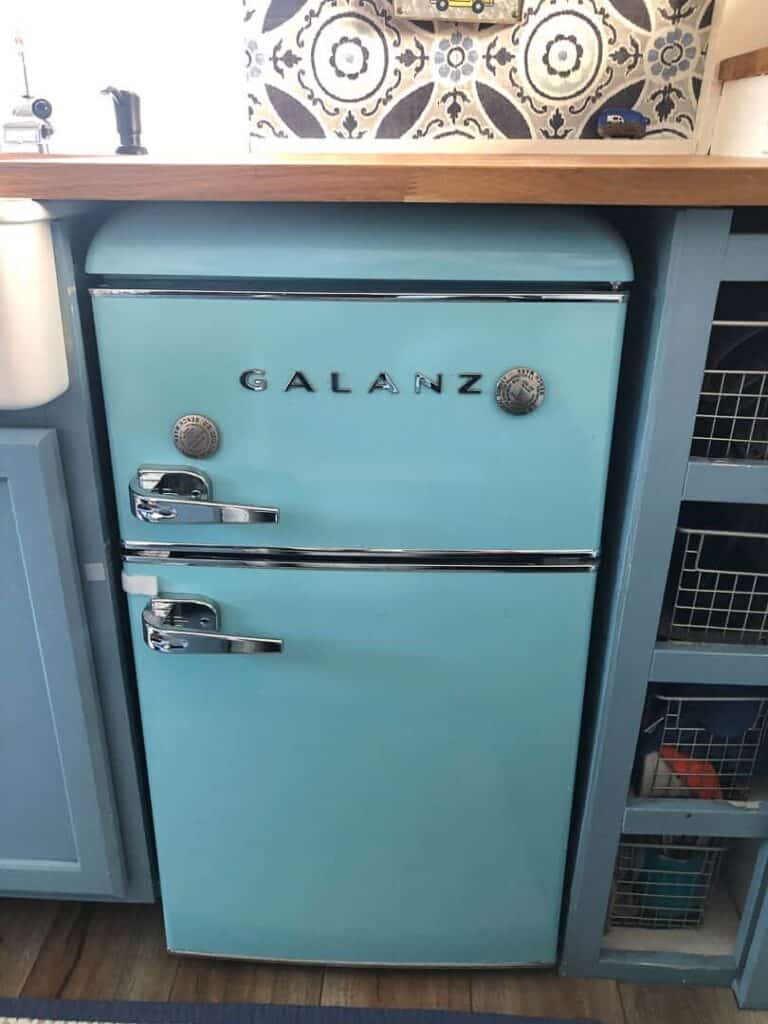
Stoves & Cooking Options
The most important part of your DIY camper van kitchen is your stove — it’s where the magic happens and your inner Gordon Ramsey comes out. You’ll be surprised what you can cook inside a camper van — the sky is the limit.
Having said this, your cooking surface is of the utmost importance in order to make these food creations come to life. You’ll also need to consider installing a vent fan if you’re going to be cooking inside your camper van.
The cooking options are as follows:
- Built-in gas/electric stove
- Double burner electric/propane cooker
- Single burner electric/butane cooker
- Portable propane cooker
- Propane camper van oven
READ NEXT: Check out these posts on our top recommended campervan stoves and campervan ovens!
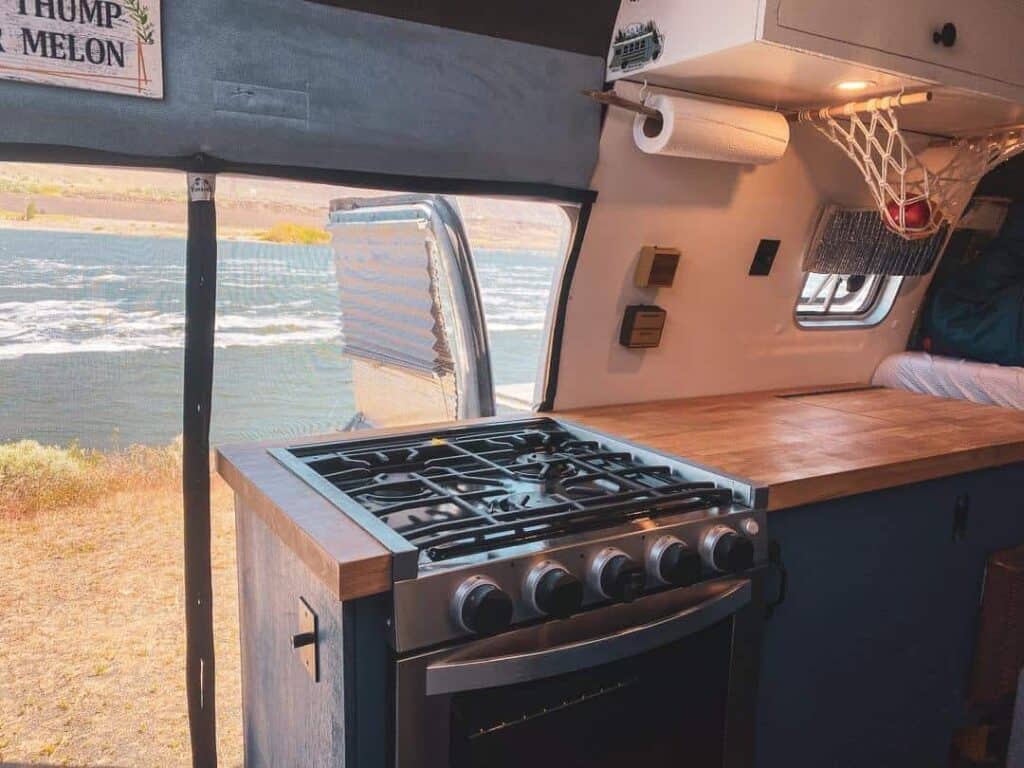
Essential Tools
Some of the essential tools and equipment that will make your life much easier when it comes to your DIY van conversion are as follows:
- A measure tape – measure twice, cut once. This should sound familiar.
- A circular saw – for cutting long, straight lines for your bed frame, storage panels, cupboards, etc.
- A cordless drill – for drilling holes, of course, but also doubles as an electronic screwdriver. You’ll thank me later.
- Drill bit and hole saw set – for drilling holes and larger cut-outs for cables, etc.
- A utility knife – probably the most handy little tool for any campervan conversion
- A jig saw – for cutting irregularly shaped holes in cupboards and the like
- A nail gun – great for attaching carpets and coverings
- A level – keeps you level-headed – literally
- A hammer – for all your nail needs — and to look like Thor during your DIY van build
DISCLAIMER: Some of the links in this article are affiliate links, which means if you book accommodation, tours or buy a product, we will receive a small commission at no extra cost to you. These commissions help us keep creating more free travel content to help people plan their holidays and adventures. We only recommend the best accommodations, tours and products that ourselves or our fantastic editorial team have personally experienced, and regularly review these. Thanks for your support, kind friend!

